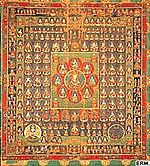List of Cultural Properties of Japan - paintings (Hiroshima)
This list is of the Cultural Properties of Japan designated in the category of paintings (絵画, kaiga) for the Prefecture of Hiroshima.[1]
National Cultural Properties
As of 1 August 2015, thirteen Important Cultural Properties (including two *National Treasures) have been designated, being of national significance.[2][3][4]
| Property | Date | Municipality | Ownership | Comments | Image | Dimensions | Coordinates | Ref. |
|---|---|---|---|---|---|---|---|---|
| *Fugen Enmei, colour on silk 絹本著色普賢延命像 kenpon chakushoku Fugen Enmei zō |
1153 | Onomichi | Jikō-ji (持光寺) |  |
149.3 centimetres (58.8 in) by 86.6 centimetres (34.1 in) | 34°24′26″N 133°11′45″E / 34.407202°N 133.195948°E | [1] | |
| *Heike Nōkyō 平家納経 Heike nōkyō |
1164 | Hatsukaichi | Itsukushima Jinja |  |
34°17′45″N 132°19′11″E / 34.295888°N 132.319835°E | [2] | ||
| Amida Triad Raigō, gold with blue ground on silk 絹本紺地金彩弥陀三尊来迎図 kenpon konji kinsai Mida sanzon raigō zu |
Muromachi period | Hatsukaichi | Kōmyō-in (光明院) | 69 centimetres (27 in) by 36 centimetres (14 in) | 34°17′49″N 132°19′19″E / 34.296879°N 132.321964°E | [3] | ||
| Yamanba, colour on silk, ema by Nagasawa Rosetsu 絹本著色山姥図〈長沢芦雪筆/(絵馬)〉 kenpon chakushoku yamanba zu (Nagasawa Rosetsu hitsu ema) |
1795 | Hatsukaichi | Itsukushima Jinja |  |
150 centimetres (59 in) by 83 centimetres (33 in) | 34°17′45″N 132°19′11″E / 34.295888°N 132.319835°E | [4] | |
| Kobayakawa Takakage, colour on silk 絹本著色小早川隆景像 kenpon chakushoku Kobayakawa Takakage zō |
1594 | Mihara | Beisan-ji (米山寺) |  |
104.7 centimetres (41.2 in) by 42.2 centimetres (16.6 in) | 34°23′28″N 132°59′59″E / 34.391093°N 132.999720°E | [5] | |
| Senju Sengen Kannon, colour on silk 絹本著色千手千眼観音像 kenpon chakushoku senju sengen Kannon zō |
Kamakura period | Onomichi | Kōsan-ji |  |
124 centimetres (49 in) by 54 centimetres (21 in) | 34°18′20″N 133°05′29″E / 34.30542524°N 133.09127839°E | [6] | |
| Nirvana painting, colour on silk 絹本著色仏涅槃図 kenpon chakushoku Butsu nehan zu |
1274 | Onomichi | Jōdo-ji (浄土寺) |  |
174.5 centimetres (68.7 in) by 133.5 centimetres (52.6 in) | 34°24′43″N 133°12′36″E / 34.411946°N 133.210110°E | [7] | |
| Nirvana painting, colour on silk 絹本著色仏涅槃図 kenpon chakushoku Butsu nehan zu |
Kamakura period | Onomichi | Kōsan-ji |  |
152.4 centimetres (60.0 in) by 140.7 centimetres (55.4 in) | 34°18′20″N 133°05′29″E / 34.30542524°N 133.09127839°E | [8] | |
| Mandala of the Two Realms, colour on silk 絹本著色両界曼荼羅図 kenpon chakushoku ryōkai mandara zu |
1317 | Onomichi | Jōdo-ji (浄土寺) | pair of scrolls |  |
Kongōkai: 251 centimetres (99 in) by 185 centimetres (73 in), Taizōkai: 263 centimetres (104 in) by 183.5 centimetres (72.2 in) | 34°24′43″N 133°12′36″E / 34.411946°N 133.210110°E | [9] |
| Yūgyō Shōnin, monochrome on paper 紙本意白描遊行上人絵〈巻第二、第五、第六、第八/〉 shihon i hakubyō Yūgyō Shōnin e |
Nanboku-chō period | Onomichi | Jōshō-ji (常称寺) | four handscrolls (2, 5, 6, 7) | 30.2 centimetres (11.9 in) by 861.5 centimetres (28.26 ft)* to 1,202.0 centimetres (39.436 ft)* | 34°24′45″N 133°12′13″E / 34.412378°N 133.203731°E | [10] | |
| Ki no Tsurayuki from the Thirty-six Poetry Immortals, colour on paper, from the Satake Collection 紙本著色三十六歌仙切〈(貫之)/佐竹家伝来〉 shihon chakushoku sanjūrokkasen setsu (Tsurayuki Satake-ke denrai) |
Kamakura period | Onomichi | Kōsan-ji |  |
35.5 centimetres (14.0 in) by 78.2 centimetres (30.8 in) | 34°18′20″N 133°05′29″E / 34.30542524°N 133.09127839°E | [11] | |
| Daitsū Zenji, colour on paper 紙本著色大通禅師像 kenpon chakushoku Daitsū Zenji zō |
Nanboku-chō period | Mihara | Buttsū-ji |  |
103 centimetres (41 in) by 41 centimetres (16 in) | 34°27′21″N 133°01′36″E / 34.455824°N 133.026586°E | [12] | |
| Landscape of the Four Seasons, ink and light colour on paper, six-panel byōbu 紙本墨画淡彩四季山水図〈/六曲屏風〉 shihon bokuga tansai shiki sansui zu (rokkyoku byōbu) |
Muromachi period | Hatsukaichi | Woodone Co Ltd (ウッドワン) (kept at the Woodone Museum of Art (ウッドワン美術館)) |
pair of screens; traditionally attributed to Shūbun but likely of a later date |   |
150.4 centimetres (59.2 in) by 347 centimetres (137 in) | 34°29′56″N 132°08′37″E / 34.498781°N 132.143633°E | [13] |
Prefectural Cultural Properties
As of 27 April 2015, forty-nine properties have been designated at a prefectural level.[4][5]
| Property | Date | Municipality | Ownership | Comments | Image | Dimensions | Coordinates | Ref. |
|---|---|---|---|---|---|---|---|---|
| Senju Kannon, colour on silk 絹本著色千手観音像 kenpon chakushoku senju Kannon zō |
Kamakura period | Onomichi | Jōdo-ji (浄土寺) |  |
34°24′43″N 133°12′36″E / 34.411946°N 133.210110°E | [14] |
See also
- Cultural Properties of Japan
- List of National Treasures of Japan (paintings)
- Japanese painting
- List of Historic Sites of Japan (Hiroshima)
References
- ^ "Pamphlet on Cultural Properties". Agency for Cultural Affairs. Retrieved 15 August 2015.
- ^ 国宝・重要文化財 (in Japanese). Agency for Cultural Affairs. 1 August 2015. Retrieved 15 August 2015.
{{cite web}}: Unknown parameter|trans_title=ignored (|trans-title=suggested) (help) - ^ 国宝・重要文化財(美術品)(絵画 広島県) (in Japanese). Agency for Cultural Affairs. Retrieved 15 August 2015.
{{cite web}}: Unknown parameter|trans_title=ignored (|trans-title=suggested) (help) - ^ a b 広島県内の指定文化財数一覧. Hiroshima Prefecture. 27 April 2015. Retrieved 15 August 2015.
{{cite web}}: Unknown parameter|trans_title=ignored (|trans-title=suggested) (help) - ^ 都道府県別指定等文化財件数(都道府県分) (in Japanese). Agency for Cultural Affairs. 1 May 2014. Retrieved 31 July 2015.
{{cite web}}: Unknown parameter|trans_title=ignored (|trans-title=suggested) (help)

